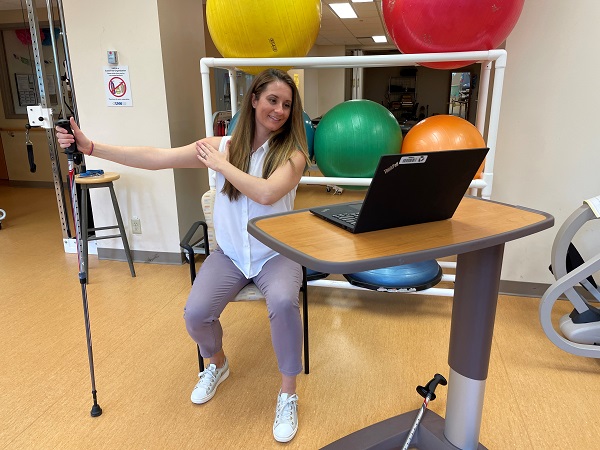Virtual care may have flourished from necessity, but its potential to deliver quality rehabilitation after injury or illness means it’s here to stay.
And a team at Toronto Rehab is sharing their robust, homegrown, Telerehabilitation Toolkit for Outpatient Rehabilitation Programs to ensure more rehabilitation centres can optimize their own delivery of virtual care.
While most ideal for centres that have started to provide virtual rehab and are now looking to expand their program, the toolkit takes teams through the entire virtual care process, from how to form an implementation team to evaluating and monitoring progress.
“The Toolkit reflects our heartfelt intention to remove as many barriers as possible, to delivering safe, efficient, and patient-centred rehabilitation,” says Dr. McKyla McIntyre, Physiatrist at Toronto Rehab-UHN and member of the development team.
Read how it can be accessed at no cost.
When the first wave of COVID was building in Ontario, the team within Toronto Rehab’s Brain Program realized they needed to pivot from in-person to a virtual care as quickly as possible.
“Our patients have time-sensitive windows to maximize their recovery after injury or illness,” says Dr. McIntyre. “We knew if their therapy was delayed, it could lead to long-term loss of function.”
The urgent need for virtual excellence
As Canada’s largest rehabilitation sciences centre, the team harnessed the expertise of staff trained in implementation sciences and quality improvement, and the experience of colleagues in the Telerehab Centre for Acquired Brain Injury (ABI), to immediately launch a virtual program that currently supports 60 per cent of their outpatient population.
They were also empowered by a leadership team committed to reimagining care, and enabling patients, families and teams through digital platforms.
“We know that in our connected future, technology will support outstanding patient experiences,” says Dr. Mark Bayley, Physiatrist-In-Chief and Program Medical Director, Toronto Rehab.
“But we needed to fast-track our approach. This meant allocating resources, and ensuring teams felt safe and supported during this innovative process.”
Recognizing that many other centres can’t leverage the same in-house resources, the team has translated their work into a toolkit that can be scalable across the broader rehabilitation community.
Chapters include the following topics:
- Getting started:How to form a team, establish a vision, and identify enablers and barriers to changing care pathways.
- Preparing patients and caregivers for outpatient telerehab: Determining who virtual care is appropriate for, setting goals and expectations, and preparing patients for meaningful participation.
- Implementing telerehab:Tools to support a safe and successful treatment session, including a safety checklist, medical event protocol, and tips for preparing the environment.
- Evaluating and monitoring: Establishing an evaluation framework
While the toolkit isn’t the only one of its kind, what sets it apart from most is its hands-on resources, including gap analysis templates, a medical event protocol, pre-and post-telerehab safety checklists, and patient and provider experience surveys.
Denise Taylor is the Physiotherapy Practice Lead for St. Joseph’s Care Group, in Thunder Bay. She says the toolkit was essential in helping their teams fill the gap, as they transitioned and expanded their existing virtual program from hospital-to-hospital, to hospital-to-home.
“From consent forms to the adverse medical event decision-making guide, we were able to lift and adapt the resources we needed, to ensure we were covering our bases,” she recalls.
“The toolkit is a perfect reflection of the rehab community’s willingness to collaborate in ways we never have before, to meet the needs of patients and each other.”
‘The potential for global, cross-centre communication and learning’
Since its launch in the fall of 2020, the toolkit has been requested more than 400 times, in Canada and beyond.
The team is encouraging feedback to help build future versions.
“The potential for global, cross-centre communication and learning is really exciting,” says Dr. McIntyre.
The team also looks forward to increasingly harnessing homegrown innovations to support patient safety.
For example, computer vision and wearable technology being developed at UHN’s KITE Research Institute include artificial intelligence (AI) algorithms that will be able to detect a patient’s heart rate and monitor exercise performance and engagement in real-time.
They also hope that greater uptake will help address health inequities that a growing reliance on virtual care are creating for older patients, ethnic minorities, and those with lower income.
“The more people who are participating in virtual care, the more advocacy we can bring to solutions such as more widely accessible internet, more dedicated staff to support digital health literacy, and programs to fund equipment and loaner devices,” says Dr. McIntyre.
These changes are hard to make in small groups, she says, but when the same issue is brought to light again and again, it makes the team hopeful that system-wide changes are possible.
Ellen Rosenberg is a Senior Public Affairs Advisor at University Health Network




